'Fantastic Beasts: Crimes of Grindelwald' Features Lots of Late-'20s Parisian High Fashion Influences
Oscar-winning costume designer Colleen Atwood takes your favorite "Harry Potter" prequel characters to the next level.
"It was fun because we were in Paris for most of the story, so I could use French references and [have] a little bit more of a fashion approach to it," says "Fantastic Beasts: Crimes of Grindelwald" costume designer Colleen Atwood, about her second time around creating the magical wardrobe for the "Harry Potter" prequel franchise.
The four-time Academy Award winner won her last Oscar statuette in 2017 for the costumes in the spin-off's first installment, "Fantastic Beasts and Where to Find Them." There's no one better to bring Magizoologist Newt Scamander (Eddie Redmayne), newly-promoted Auror Tina Goldstein (Katherine Waterstone) and her sweet (and super-chic) sister Queenie (Alison Sudol) into their next chapter, as the three Apparate over to the City of Lights to save Credence Barebone (Ezra Miller, currently killing it on the red carpet).
Atwood also had the privilege of reimagining future Harry Potter mentor Albus Dumbledore as a young, dreamy wizard, played by Jude Law, via tweedy and perfectly tailored three-piece suits. She brought more capital-F Fashion with Newt's Hogwarts classmate Leta Lestrange (Zo? Kravitz) and wizard dictator, Grindelwald's sidekick Rosier (Poppy Corby-Tuech). The legendary costume designer jumped on the phone with Fashionista right before "Fantastic Beasts: The Crimes of Grindelwald" opens in theaters. Read on for the highlights.

What fashion inspirations and references did you look to for the film, especially with the Paris setting?
We're in a great period in Paris, where there was great writing, great art, great theaters, great photographers. I gleaned a lot of visual information from old photography of Paris in the period: Man Ray, Brassa?. Even if some of it was later, it had that gritty mood of Paris. The fashion in Paris was cutting-edge at that time in the world, so it was interesting to add that to it, as well.
Tina is tougher and more confident in this movie, supported by the most gorgeous blue leather duster coat. What was the inspiration was behind the design?
Well, Katherine and I saw a picture of just a collar on a duffle coat from that era. Because Tina tucks her hair into the collar, I took that collar, but then applied it to a long trench coat. I found this amazing navy blue leather in the States that actually influenced where I wanted to go color-wise with it — just because it was such an unusual color for leather and got me out of the brown-slash-black leather world.
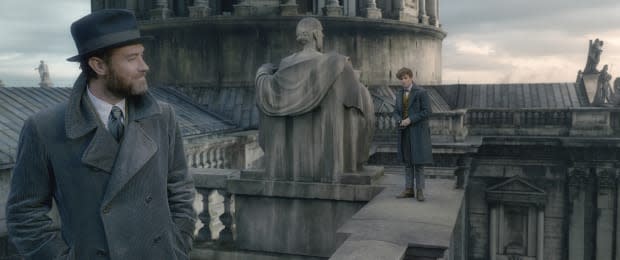
Regarding Jude Law's young, dreamier version of Albus Dumbledore: When you first see him, his corduroy coat really jumped off the screen. How did the coat and his tweed-y, three-piece high-waisted suits communicate a mentor-in-training?
I really wanted Dumbledore to be approachable and have a warmth to him as a character, like him being the most approachable professor at Hogwarts in his youth. Also, Jude and I liked the idea of the professorial feeling, and the tweed and the corduroy — this relaxed country vibe that it has in the English culture. I'm a huge fan of corduroy. I love it. I think it's a great fabric and it photographs interestingly. I thought, 'Rather than just doing a corduroy blazer, let's do a beautiful corduroy coat cut in a way that you'd cut a much finer coat, but use a more affordable fabric.' It was really fun to get it and break it down, so it had a real lived-in quality. It looks comfortable quickly on camera.
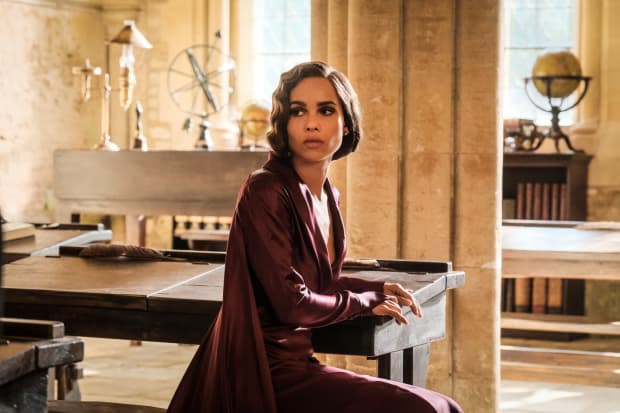
Leta Lestrange wears this beautiful deep purple cape gown that nods to the '30s. What went into the cape design and specific color choice — and what is it telling us about her?
It's a combination of late '20s into the '30s, and definitely edgier than the usual '20s cut. I tweaked the fabric in that direction, but I was like, 'How can I make it have the feeling of the cape in this magical world? How can it feel like the period, but be a cape without being a cape?' So I added the element on the back, which I actually found on a real vintage piece, but in a much less dramatic way.
The color came from... I just saw this beautiful prune-colored piece of fabric, and I'm not a huge purple fan, but I love when brown gets mixed in with purple. That was just the right cocktail of those tonalities. I thought, 'That should be Leta's dress.' She's manor-born. She's a pure-blood [witch]. She is aristocracy, but in an unassuming way. It's just her life; that's how it is, without it being a big moment.
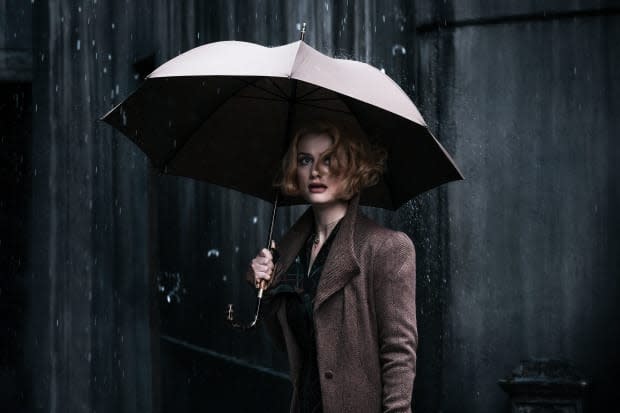
Queenie's soft pink '20s looks in the first movie were my favorite. She's less innocent and girlish in this movie, which is reflected in her darker color scheme. What was the design inspiration behind her tartan dress?
It's funny. I had a first fitting with Alison and we talked about the color. We felt like she needed more of a shell around her for this character. She was sheltered a little bit [in the first movie] and not quite as vulnerable as she had been previously. I had some different dress shapes to try on her and she said, 'You know, I always thought Queenie could be in a plaid.' I said, 'Oh, that's an interesting idea. I like that.'
I found a dress [shape] we really liked and then I found this really great piece of '30s plaid fabric in Berlin, but I found about six inches of it. It wasn't enough to make anything. I took the idea of the plaid and added some color to it and we printed this plaid for all her dresses. It's definitely a period [print], but I cheated with a new fabric. For her coat she wears when she enters the film, it's a nod to that peachy tonality that she wore through the first film. Once she loses that, she's vulnerable in a different kind of way.
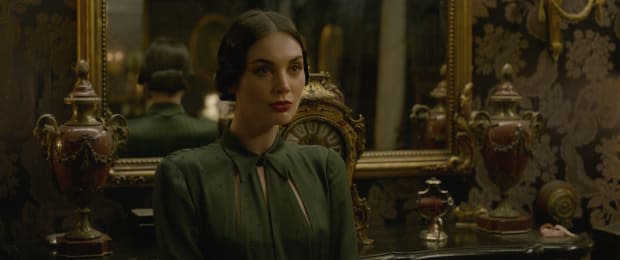
Grindelwald's right hand woman, Rosier, is so chic, especially in the cut-out green dress and her riding pants. How did you infuse evil spy-meets-Parisian glamour into her outfits?
I took the hats from the early '30s and gave them a wicked nod toward magic and wizardry and did really serious neo-modern tailoring to the pant look for the end sequence. I fell in love with green on her; her coat and hat and dress all reflect the alpine forest colors in Grindelwald's world. I used those color and tonalities on the people around him, she being the most outstanding version of it.
We very briefly see Jessica Williams's character, Eulalie "Lally" Hicks, a professor at the American counterpart to Hogwarts, but in black and white. What does her full costume look like?
At that point in history, Lally is part of the magical world of the elite professorial intellectuals. I made her a really tailored suit, like a power suit of the time, but with a little cape feature to it. Sadly, you don't see much of it in the movie — you just see her face — but still, the idea of her strength is reflected. It's a beautiful soft cashmere plaid, but really muted with a blue lining, which is a hopeful color.
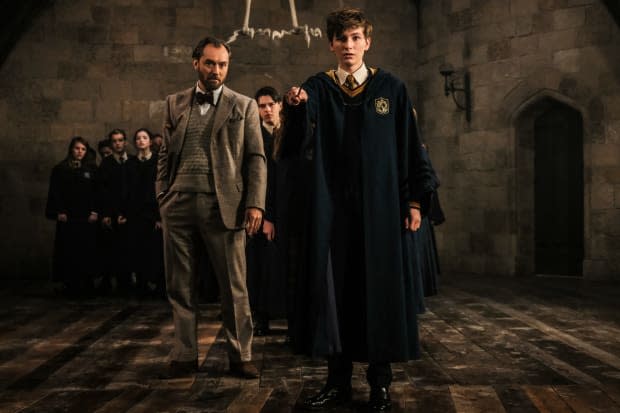
The movie flashes back to Newt, Leta and Dumbledore's earlier days at Hogwarts, and the uniforms were a bit different. What was the inspiration behind those tweaks? Did you incorporate any "Harry Potter" Easter eggs?
That kind of robe more or less is a medieval design, so I refined them a little bit from the last picture. I made the sleeves a little bit thinner and the cuff on the bottom a little wider and I made them longer and the skirts longer, like the early straightforward '20s school uniform underneath. But the emblem for the houses and the colors remain the same as a constant throughout what I did before, which was taken off the earlier ones. I just changed the fabric and added velvet stripes for textural aesthetic reasons, but basically, it's the beloved Hogwarts again, with a different twist.
This interview has been edited and condensed for clarity.
Homepage and top photo: Courtesy of Warner Bros. Pictures
Never miss the latest fashion industry news. Sign up for the Fashionista daily newsletter.